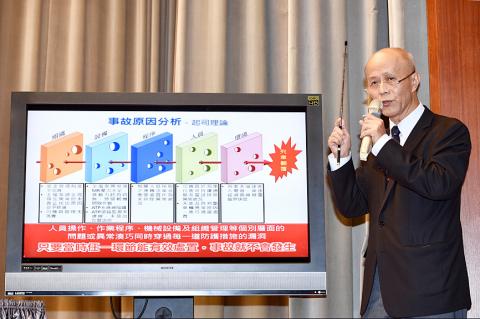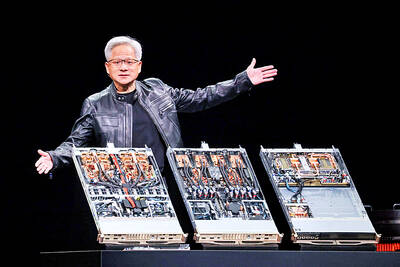The derailment of a Puyuma Express train in Hualien last month was caused by the Taiwan Railways Administration’s (TRA) failure to address a series of loopholes in its safety mechanism, an Executive Yuan investigative team concluded yesterday.
Eighteen people died and 267 were injured when Puyuma Express No. 6432 derailed outside Sinma Train Station (新馬) in Yilan County on Oct. 21.
The high number of casualties prompted the Cabinet to assemble a team to investigate the cause.

Photo: Peter Lo, Taipei Times
The team, led by Minister Without Portfolio Wu Tze-cheng (吳澤成), released the preliminary results of its investigation ahead of Premier William Lai’s (賴清德) briefing at the Legislative Yuan today.
The team would identify the problems facing the railway agency and propose solutions based on the facts and the cause of the accident, Wu said at a presentation to share the team’s findings.
Railway Bureau Director-General Allen Hu (胡湘麟) said that members of the team reviewed all the evidence, including footage from surveillance cameras, data recorded on the train control and management system, the automatic train protection (ATP) system’s data log, and communication logs between the conductor and the train dispatcher.
The team found that two of four air compressors on the train had been operating abnormally before it departed from Shulin Station (樹林), Hu said.
The air tanks had low pressure as the train left Cidu Station (七堵), which led to an unstable power supply and caused it to stop intermittently 10 times, he said.
To resolve the problem with the air compressors, the conductor turned off the ATP system and informed the dispatcher that he had done so.
In response, the dispatcher questioned whether turning off the system would solve the problem, Hu said.
The team also found that the train’s ATP system was not connected to a remote monitoring system, Hu said, adding that this explains why the system did not receive any speeding alerts.
Investigators laid out the timeline of the events in the last five minutes before the train derailed.
The train accelerated to 140kph about two minutes after it left Luodong Station (羅東), they said.
They found that the driver at 4:46pm started talking on the telephone with the dispatcher to resolve the power supply issue, but he did not operate the braking system to slow the train before it entered the curve at Sinma Station, which has a radius of 306m.
The speed limit for the curve is 75kph, Hu said.
However, the train’s operational speed reached 141kph as it entered the curve at 4:49pm, which consequently led to the derailment, the team said.
The ATP stopped recording data at 4:49:28pm, when the throttle control was moved to “off” position and the train’s speed was last recorded as 135kph.
The investigative team applied the “Swiss cheese model” of accident causation, which is commonly used in large transportation accidents, and concluded that it happened because of a series of loopholes in safety precautions and procedures, from operating procedures and errors in the machinery to organizational management.
The accident would not have happened if the problem or the abnormality was handled when it was identified, the team said.
The train’s tilting device, speed handle, digital speedometer and other devices were functioning normally, it said.
The team said that it would entrust an academic institution to conduct simulations and collision tests to make sure that its conclusion is supported by scientific analysis and experiments.
The TRA has been asked to adopt measures to improve the safety of its operations, such as ensuring that train drivers do not turn off the ATP unilaterally and slow the train if they have a legitimate reason to deactivate the device.
The team also found that the train’s ATP system was not connected to a remote monitoring system, Hu said, adding that this explains why the system did not receive any speeding alerts.
Investigators laid out the timeline of the events in the last five minutes before the train derailed.
The train accelerated to 140kph about two minutes after it left Luodong Station (羅東), they said.
They found that the driver at 4:46pm started talking on the telephone with the dispatcher to resolve the power supply issue, but he did not operate the braking system to slow the train before it entered the curve at Sinma Station, which has a radius of 306m.
The speed limit for the curve is 75kph, Hu said.
However, the train’s operational speed reached 141kph as it entered the curve at 4:49pm, which consequently led to the derailment, the team said.
The ATP stopped recording data at 4:49:28pm, when the throttle control was moved to “off” position and the train’s speed was last recorded as 135kph.
The investigative team applied the “Swiss cheese model” of accident causation, which is commonly used in large transportation accidents, and concluded that it happened because of a series of loopholes in safety precautions and procedures, from operating procedures and errors in the machinery to organizational management.
The accident would not have happened if the problem or the abnormality was handled when it was identified, the team said.
The train’s tilting device, speed handle, digital speedometer and other devices were functioning normally, it said.
The team said that it would entrust an academic institution to conduct simulations and collision tests to make sure that its conclusion is supported by scientific analysis and experiments.
The TRA has been asked to adopt measures to improve the safety of its operations, such as ensuring that train drivers do not turn off the ATP unilaterally and slow the train if they have a legitimate reason to deactivate the device.

Nvidia Corp yesterday unveiled its new high-speed interconnect technology, NVLink Fusion, with Taiwanese application-specific IC (ASIC) designers Alchip Technologies Ltd (世芯) and MediaTek Inc (聯發科) among the first to adopt the technology to help build semi-custom artificial intelligence (AI) infrastructure for hyperscalers. Nvidia has opened its technology to outside users, as hyperscalers and cloud service providers are building their own cost-effective AI chips, or accelerators, used in AI servers by leveraging ASIC firms’ designing capabilities to reduce their dependence on Nvidia. Previously, NVLink technology was only available for Nvidia’s own AI platform. “NVLink Fusion opens Nvidia’s AI platform and rich ecosystem for

‘WORLD’S LOSS’: Taiwan’s exclusion robs the world of the benefits it could get from one of the foremost practitioners of disease prevention and public health, Minister Chiu said Taiwan should be allowed to join the World Health Assembly (WHA) as an irreplaceable contributor to global health and disease prevention efforts, Minister of Foreign Affairs Lin Chia-lung (林佳龍) said yesterday. He made the comment at a news conference in Taipei, hours before a Taiwanese delegation was to depart for Geneva, Switzerland, seeking to meet with foreign representatives for a bilateral meeting on the sidelines of the WHA, the WHO’s annual decisionmaking meeting, which would be held from Monday next week to May 27. As of yesterday, Taiwan had yet to receive an invitation. Taiwan has much to offer to the international community’s

CAUSE AND EFFECT: China’s policies prompted the US to increase its presence in the Indo-Pacific, and Beijing should consider if this outcome is in its best interests, Lai said China has been escalating its military and political pressure on Taiwan for many years, but should reflect on this strategy and think about what is really in its best interest, President William Lai (賴清德) said. Lai made the remark in a YouTube interview with Mindi World News that was broadcast on Saturday, ahead of the first anniversary of his presidential inauguration tomorrow. The US has clearly stated that China is its biggest challenge and threat, with US President Donald Trump and US Secretary of Defense Pete Hegseth repeatedly saying that the US should increase its forces in the Indo-Pacific region

ALL TOGETHER: Only by including Taiwan can the WHA fully exemplify its commitment to ‘One World for Health,’ the representative offices of eight nations in Taiwan said The representative offices in Taiwan of eight nations yesterday issued a joint statement reiterating their support for Taiwan’s meaningful engagement with the WHO and for Taipei’s participation as an observer at the World Health Assembly (WHA). The joint statement came as Taiwan has not received an invitation to this year’s WHA, which started yesterday and runs until Tuesday next week. This year’s meeting of the decisionmaking body of the WHO in Geneva, Switzerland, would be the ninth consecutive year Taiwan has been excluded. The eight offices, which reaffirmed their support for Taiwan, are the British Office Taipei, the Australian Office Taipei, the